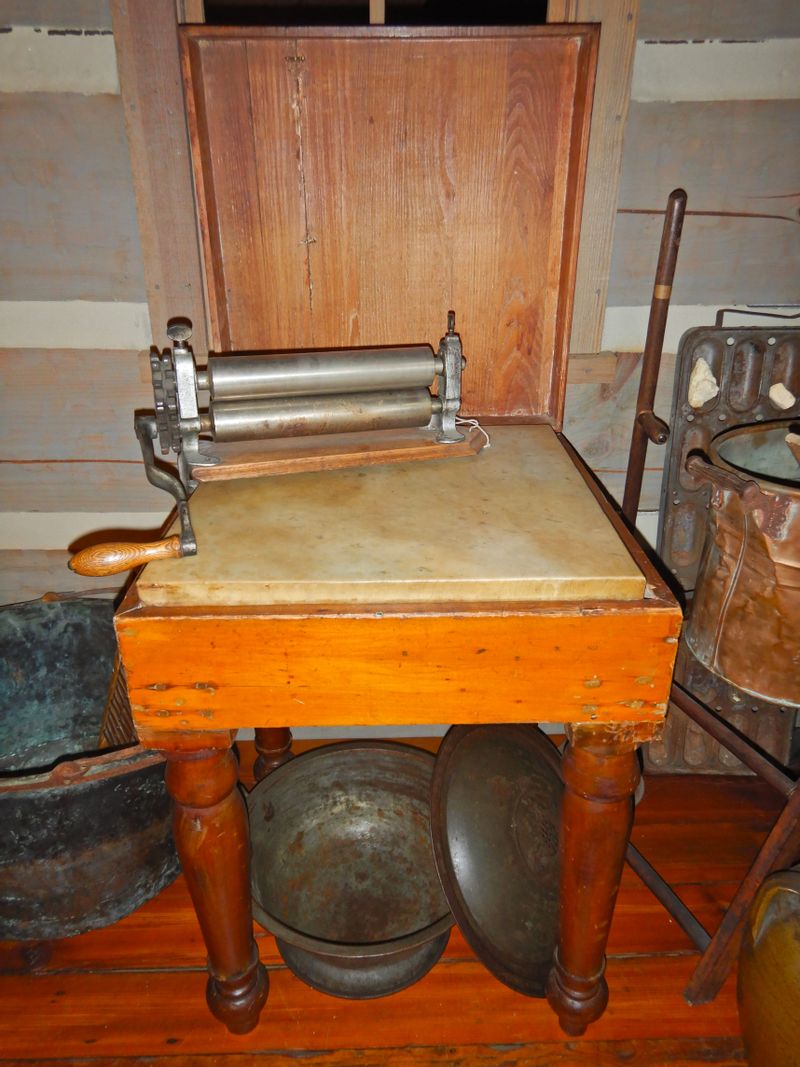Beaten Biscuits
Last Updated 4/30/2024
By Jubilee P. Reid

“Biscuit” can refer to a variety of different foods. Most people in the South today think of a biscuit as a soft, fluffy type of bread accompanied by sausage gravy or jam. However, this kind of biscuit is a relatively modern food and did not exist until the production of baking soda was introduced to America.
The first factory in America to produce sodium bicarbonate (baking soda) was established in 1846. Baking powder (a combination of baking soda and a weak acid) took another decade to come into use. Even after these leavening agents became available, it took many more years for them to become widely used. Before the invention of baking soda, biscuits in the Southern states were a hard, dense bread similar to hardtack. Originally referred to as “Maryland biscuits,” this type of biscuit is also called “sea biscuits,” “beaten biscuits” or “cold water biscuits.”
Beaten biscuits were made with flour, cold water, lard, salt and sometimes sugar. Unlike the flaky buttermilk biscuits of today, beaten biscuits did not contain soured milk. These biscuits get their name from the time-consuming process required to make them. The dough must be kneaded until elastic, then beat with a rolling pin, mallet, or sometimes an axe handle, to create air pockets. This laborious process could take over an hour to yield the desired consistency. The dough would then be rolled out, cut with a biscuit cutter, and pricked with a fork before baking. The final product is similar to a puffy cracker and would keep longer than other breads.
This form of biscuit appeared along the Chesapeake and North Carolina coast in the 1700s. The British Royal Navy used these biscuits on their ships and likely brought them to the New England colonies. In the antebellum South, beaten biscuits were a sign of wealth. As Jai Jordan, former site manager of Historic Brattonsville in South Carolina, said “biscuits meant you could afford kitchen help. Biscuits at breakfast meant someone got up and made them for your pleasure.” This “kitchen help” was usually enslaved cooks working at Southern residences.
In the 19th century, a specific type of table was often used to make beaten biscuits. Similar to tables used for making confections, these were topped with a stone slab, usually, limestone, granite, or marble. Biscuit tables often had a hinged lid to keep flies out of the dough and cover the stone when not in use. The stone slab would aid in keeping the dough cool and would not stick to the dough as much as wood. Poplar wood was often used for making these tables which could be crudely built or include ornately carved designs.
Among the McMinn County Living Heritage Museum’s collection is an antique biscuit table. Originally from a home in Sullivan County, Tennessee on the Kentucky state line, this small table is approximately 30 inches tall. A square 2.5-inch-thick stone slab is set into the tabletop.
As an easier method for making these labor-intensive biscuits was sought after, the biscuit brake was invented in the years following the Civil War. Similar to a clothes wringer, this tool consists of two cylindrical rollers operated by a crank handle and was designed to be clamped to a kitchen table. In the museum’s General Store exhibit a biscuit brake is displayed. This device is 18 inches long with a six-inch-wide wooden base. The top roller can be removed for cleaning. This biscuit brake has a small round biscuit cutter attached with prongs inside it. Biscuit brakes made the process of making these biscuits much easier by eliminating the manual beating process, instead rolling the dough repeatedly into thin layers. Biscuit brakes could be made by modifying similar rolling tools and a few were even connected to treadles from old sewing machines to eliminate the use of a hand crank.
Karen Petit, a columnist for The Index-Journal, a South Carolina newspaper, summed up beaten biscuits in a 1982 article stating, “…the biscuits are pretty hard, and I tend to think that maybe the [Civil War] soldiers could have used them as bullets in their guns… When I think I might have had to beat biscuits with an axe, I feel lucky…”
Though few people make beaten biscuits today and commercial producers of beaten biscuits are long gone, there are many antique recipes available for those who wish to try this historic staple.

